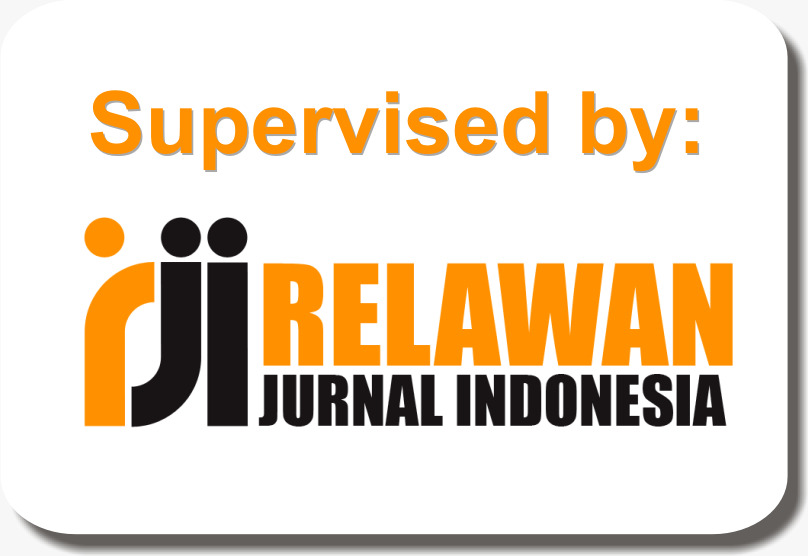CRICKET PRODUCTION FORECASTING USING THE MOVING AVERAGE METHOD
Abstract
Keywords
Full Text:
PDFArticle Metrics :
References
I. Zulkarnaen, R. I. Rosihan, and R. Muhendra, “PERBAIKAN PENGELOLAAN TERNAK JANGKRIK GUNA MENINGKATKAN HASIL PRODUKSI DAN PENJUALAN,” 2021.
F. Maulana, F. Fajri, B. P. Febrina, A. M. Ali, N. Jannah, and S. Norazizah, “Pengaruh Umur Panen Berbeda terhadap Kandungan Nutrisi dan Analisa Kelayakan Usaha Jangkrik Alam Budidaya di Kalimantan Selatan,” JPI, vol. 25, no. 2, p. 194, Jun. 2023, doi: 10.25077/jpi.25.2.194-205.2023.
A. Halloran, N. Roos, and Y. Hanboonsong, “Cricket farming as a livelihood strategy in Thailand,” Geographical Journal, vol. 183, no. 1, pp. 112–124, Mar. 2017, doi: 10.1111/geoj.12184.
H. J. O. Magara et al., “Edible Crickets (Orthoptera) Around the World: Distribution, Nutritional Value, and Other Benefits—A Review,” Front. Nutr., vol. 7, Jan. 2021, doi: 10.3389/fnut.2020.537915.
M. Arvan, B. Fahimnia, M. Reisi, and E. Siemsen, “Integrating human judgement into quantitative forecasting methods: A review,” Omega, vol. 86, pp. 237–252, Jul. 2019, doi: 10.1016/j.omega.2018.07.012.
Saefudin, D. Susandi, and F. Nafis, “SISTEM PERAMALAN PENJUALAN PAVING BLOCK MENGGUNAKAN METODE SINGLE MOVING AVERAGE,” JSiI, vol. 8, no. 2, pp. 75–81, Sep. 2021, doi: 10.30656/jsii.v8i2.3727.
M. Latif and R. Herdiansyah, “Peramalan Persediaan Barang Menggunakan Metode Weighted Moving Average dan Metode Double Ex-ponential Smoothing,” josh, vol. 3, no. 2, pp. 137–142, Jan. 2022, doi: 10.47065/josh.v3i2.1232.
Anna Nita Kusumawati, Muhammad Ghofur, Mega Anggraeni Putri, Zaki Abdullah Alfatah, and Mu’adzah, “Peramalan Permintaan Menggunakan Time Series Forecasting Model Untuk Merancang Resources Yang Dibutuhkan IKM Percetakan,” jenius, vol. 2, no. 2, pp. 105–115, Nov. 2021, doi: 10.37373/jenius.v2i2.159.
F. Ustadatin, A. Muqtadir, and A. Arifia, “Implementasi Metode Weighted Moving Average (WMA) Pada Prediksi Harga Bahan Pokok,” Komputika, vol. 12, no. 2, pp. 83–90, Sep. 2023, doi: 10.34010/komputika.v12i2.10304.
F. Ahmad, “PENENTUAN METODE PERAMALAN PADA PRODUKSI PART NEW GRANADA BOWL ST Di PT.X,” JISI, vol. 7, no. 1, p. 31, May 2020, doi: 10.24853/jisi.7.1.31-39.
M. Siregar, S. Pandiangan, and D. Anwar, “Planning Production Capacity Using Time Series Forecasting Method and Linier Program-ming,” Engineering Management Research, 2018, Accessed: Jan. 16, 2025. [Online]. Available: https://www.semanticscholar.org/paper/Planning-Production-Capacity-Using-Time-Series-and-Siregar-Pandiangan/f3cb404a51f3e1438e7ae4702f8fc6caeb8b6783
S. Nurhayati and A. Syafiq, “Sistem Prediksi Jumlah Produksi Baju Menggunakan Weighted Moving Average,” JAMIKA, vol. 12, no. 1, pp. 14–24, Mar. 2022, doi: 10.34010/jamika.v12i1.6680.
F. Irawan, S. Sumijan, and Y. Yuhandri, “Prediksi Tingkat Produksi Buah Kelapa Sawit dengan Metode Single Moving Average,” jidt, pp. 251–256, Sep. 2021, doi: 10.37034/jidt.v3i4.162.
I. G. Anjani, A. B. Saputri, A. N. P. Armeira, and D. Januarita, “Analisis Konsumsi Dan Produksi Minyak Kelapa Sawit Di Indonesia Dengan Menerapkan Metode Moving Average,” Jur. Ris. Kom., vol. 9, no. 4, p. 1014, Aug. 2022, doi: 10.30865/jurikom.v9i4.4506.
N. Azahra, S. C. Alifia, N. P. Andyka, S. Wijayanto, and M. Y. Fathoni, “Peramalan Jumlah Produksi Tebu Menggunakan Metode Time Series Model Moving Averages,” Jur. Ris. Kom., vol. 9, no. 4, p. 840, Aug. 2022, doi: 10.30865/jurikom.v9i4.4388.
A. Nyangarika, A. Mikhaylov, and U. Henning Richter, “Oil Price Factors: Forecasting on the Base of Modified Auto-regressive Inte-grated Moving Average Model,” IJEEP, vol. 9, no. 1, pp. 149–159, 2019.
S. Hansun, “A new approach of moving average method in time series analysis,” in 2013 Conference on New Media Studies (CoNMe-dia), Tangerang, Indonesia: IEEE, Nov. 2013, pp. 1–4. doi: 10.1109/CoNMedia.2013.6708545.
S. Kim and H. Kim, “A new metric of absolute percentage error for intermittent demand forecasts,” International Journal of Forecast-ing, vol. 32, no. 3, pp. 669–679, Jul. 2016, doi: 10.1016/j.ijforecast.2015.12.003.
T. O. Hodson, “Root-mean-square error (RMSE) or mean absolute error (MAE): when to use them or not,” Geoscientific Model Devel-opment, vol. 15, no. 14, pp. 5481–5487, Jul. 2022, doi: 10.5194/gmd-15-5481-2022.
D. Chicco, M. J. Warrens, and G. Jurman, “The coefficient of determination R-squared is more informative than SMAPE, MAE, MAPE, MSE and RMSE in regression analysis evaluation,” PeerJ Comput. Sci., vol. 7, p. e623, Jul. 2021, doi: 10.7717/peerj-cs.623.




